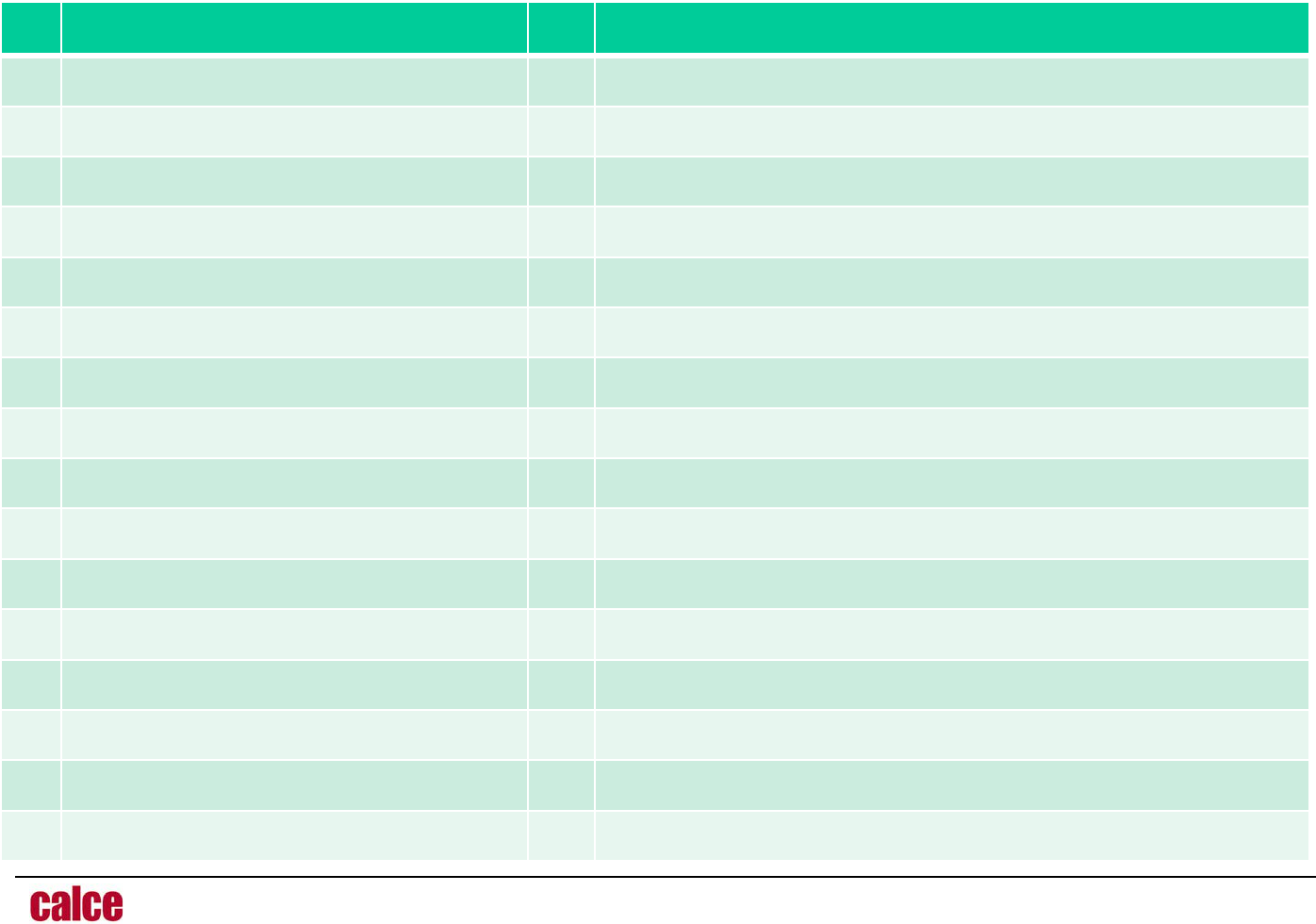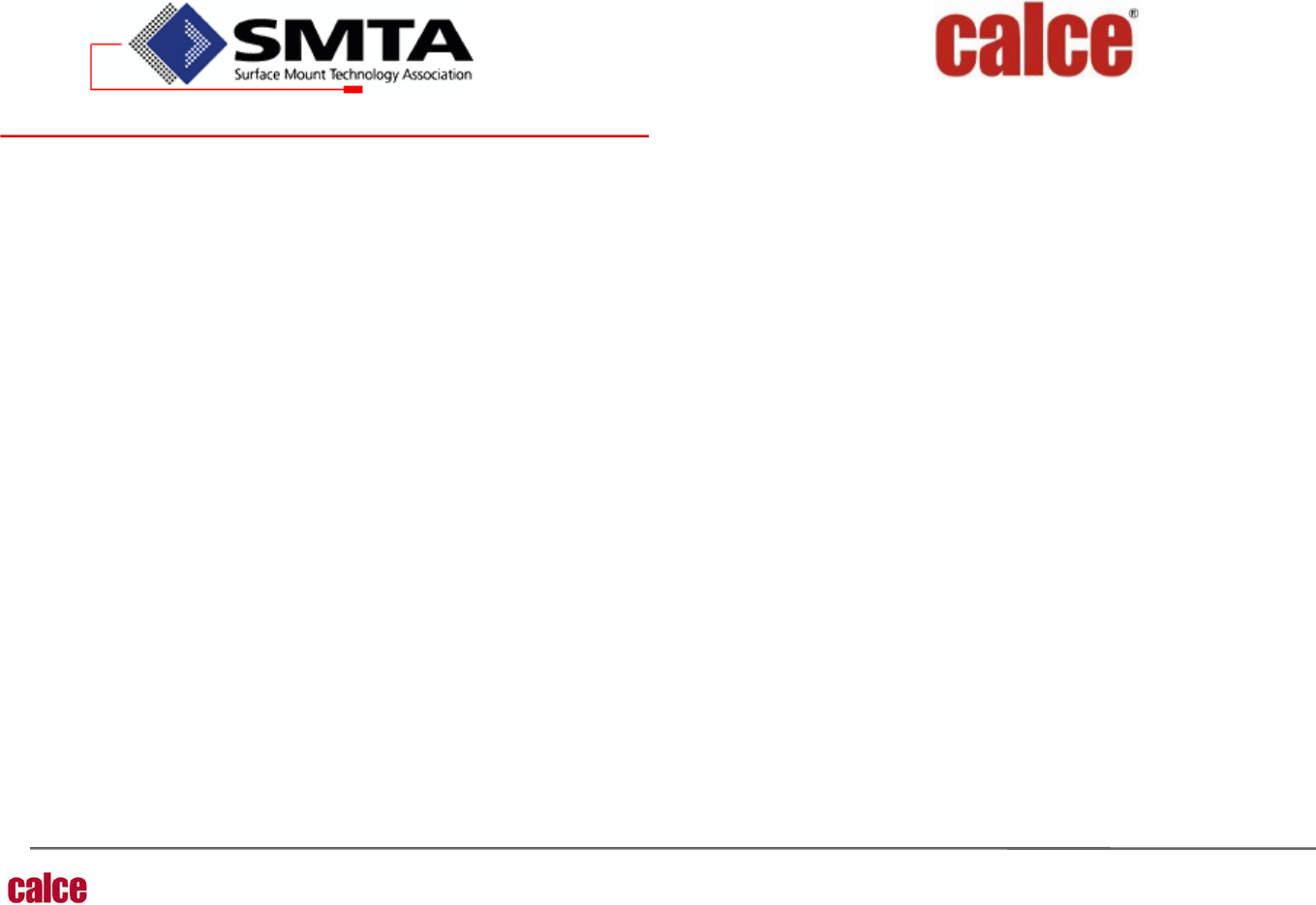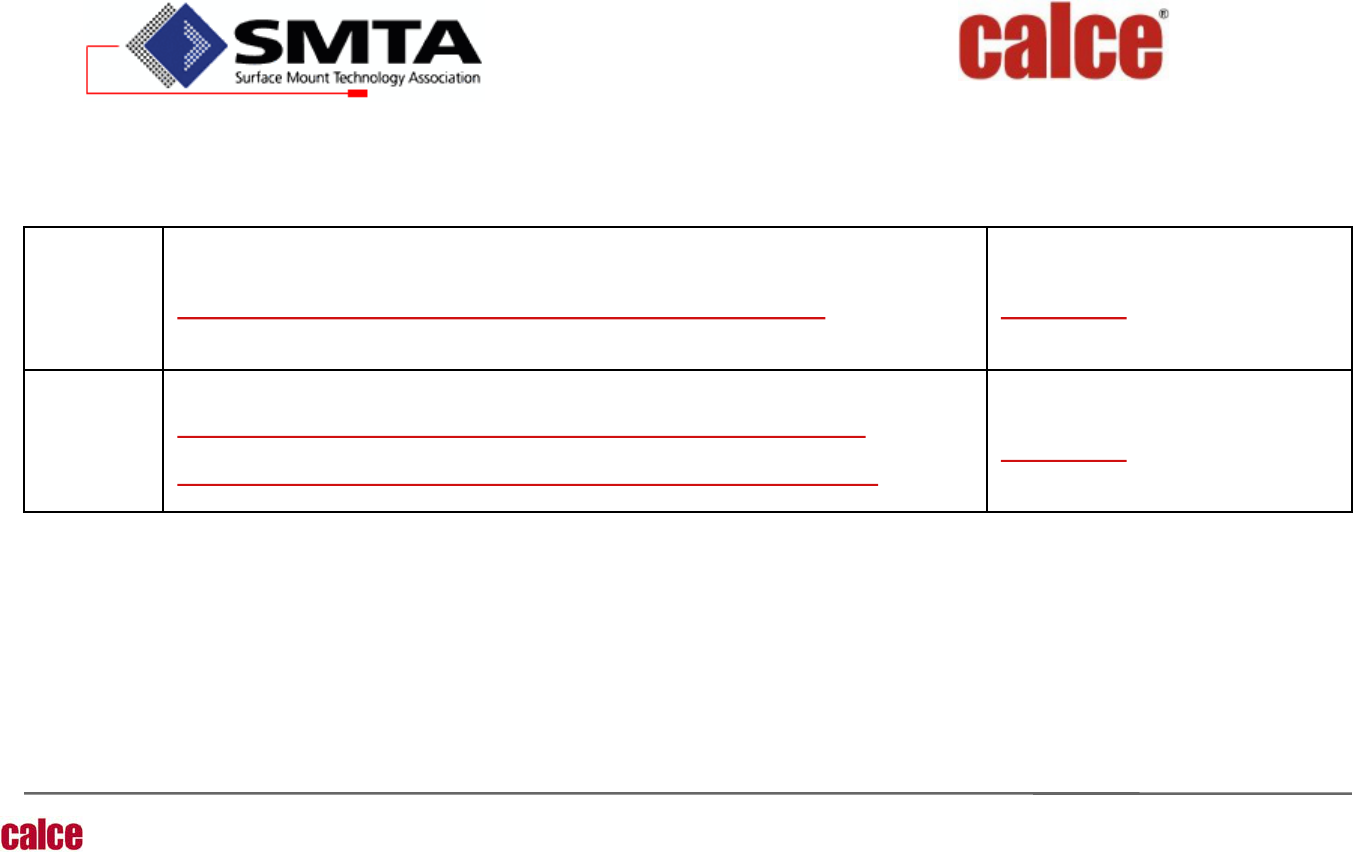
University of Maryland
© CALCE
2
Center for Advanced Life Cycle Engineering
CALCE Overview
• The Center for Advanced Life Cycle Engineering (CALCE) at the University
of Maryland, College Park formally started as an NSF Center of Excellence
in electronics systems reliability (1984).
• One of the world’s most advanced and comprehensive testing and
failure analysis laboratories.
• Funded by over 150 of the world’s leading companies.
• Supported by about 100 faculty, visiting scientists, research assistants and
interns.
• Received NSF innovation award in 2009 and IEEE standards education
award in 2013.

University of Maryland
© CALCE
3
Center for Advanced Life Cycle Engineering
What is a Counterfeit Electronic Part?
• A counterfeit electronic part is one whose identity has
been deliberately misrepresented.
• Identity of an electronic part includes:
• Manufacturer,
• Part number,
• Date and lot code,
• Reliability level,
• Inspection/Testing,
• Documentation.
(2011): Screening for counterfeit electronic parts, Journal of Materials Science, Materials in Electronics 22:1511-1522
“Semiconductor Manufacturers’ Efforts to Improve Trust in the Electronic Part Supply Chain”,
IEEE Transactions on Components and Packaging Technology, Vol. 30, No. 3, pp. 547 – 549, September 2007.

University of Maryland
© CALCE
4
Center for Advanced Life Cycle Engineering
Possible Sources of Parts Used to Create
Counterfeits
Part
Manufacturers
Authorized
Distributors
OEMs/CMs
Package Assembly
and Testing
Companies
Recyclers
Scrap parts
CMs
Reclaimed parts from
discarded electronics
Unauthorized
parts
Sold “As Is”
Creation of Counterfeits
Recycled OverproducedRemarked
Out-of-
spec/Defective
Cloned
Forged
Documentation
Tampered
Test
Laboratories

University of Maryland
© CALCE
5
Center for Advanced Life Cycle Engineering
G-19 & G-21 Counterfeit Avoidance,
Detection, Mitigation & Disposition
Committee Update
1. OEMS/Users of
Electronics,
Electric,
Electromechanic
al (EEE): AS5553
2. OEMS/Users of
Materiel (other than
EEE): AS6174
3. Independent
Distributors/Brokers of
Electronics: AS6081
4. Authorized
Distribution of
Electronics: AS6496
5. Test Laboratories
of EEE: AS6171
G-19 & G-21 Counterfeit Prevention & Detection
Standards
ARP 6328 and AIR 6273
5

University of Maryland
© CALCE
6
Center for Advanced Life Cycle Engineering
Summary of SAE G-19 Aerospace Standards
Standard Title
SAE AS5553 Rev B Counterfeit Electrical, Electronic, and Electromechanical (EEE)
Parts; Avoidance, Detection, Mitigation, and Disposition –
Published 9/2016
ARP6328 Guideline for Development of Counterfeit Electronic Parts;
Avoidance, Detection, Mitigation, and Disposition Systems –
Published 9/2016
SAE AS6462 AS5553 Verification Criteria – Under revision
SAE AS6171 Test Methods Standard; General Requirements,
Suspect/Counterfeit, Electrical, Electronic, and Electromechanical
Parts – Published 10/2016
SAE AS6081 Counterfeit Electronic Parts Avoidance – Distributors – Preparing
release of revision and in discussion on the test methods
SAE ARP6178 Fraudulent/Counterfeit Electronic Parts; Tool for Risk Assessment
of Distributors
SAE AIR6273 AIR6273 - Terms, Definitions, and Acronyms - Counterfeit Materiel
or Electrical, Electronic and Electromechanical Parts – under ballot
SAE AS6496 Fraudulent/Counterfeit Electronic Parts: Avoidance, Detection,
Mitigation, and Disposition - Authorized/Franchised Distribution

University of Maryland
© CALCE
7
Center for Advanced Life Cycle Engineering
Test Methods Covered in the 6171 Slash Sheets
• AS6171/2: External Visual Inspection (EVI) (incl. remarking, resurfacing,
weight, dimensions, SEM)
• AS6171/3: X-Ray Fluorescence (XRF) (incl. lead finish, thickness)
• AS6171/4: Delid/Decapsulation Physical Analysis (DDPA)
• AS6171/5: Radiological Inspection (RI): X-ray imaging
• AS6171/6: Acoustic Microscopy (AM): external and internal
• AS6171/7: Electrical Test: Curve Trace, Full DC, Key Electrical
Parameters for AC, Switching, and Functional Tests; ambient or over
temperature (incl. environmental, burn-in, seal)
• AS6171/8: Raman Spectroscopy: materials identification
• AS6171/9: Fourier Transform Infrared Spectroscopy (FTIR): materials
identification
• AS6171/10: Thermogravimetric Analysis (TGA): material analysis
• AS6171/11: Design Recovery (DR): device layout and function
7

University of Maryland
© CALCE
8
Center for Advanced Life Cycle Engineering
8
AS6171 – Future Test Methods
Description Status
Acoustic Microscopy (AM) Test Method for Capacitors Dec 2016: initial
ballot
Secondary Ion Mass Spectroscopy (SIMS) Test Method April 2017: initial
ballot
Radiated Electromagnetic Emission (REME) Test Methods In development
Packaging Test Methods In development
Netlist Assurance Test Methods In development
Laser Scanning Microscopy (LSM) Test Methods In development
Thermomechanical Analysis (TMA) Test Methods In development
Assembly Test Methods Workgroup in
formation
Scanning Electron Microscopy (SEM) Test Methods Workgroup in
formation

University of Maryland
© CALCE
9
Center for Advanced Life Cycle Engineering
Each Test Method Includes:
• Processes and a description of procedures
• Apparatus needed for the test technique
• Required qualification and certification of
processes and personnel
• Guidelines and requirements for reporting
9

University of Maryland
© CALCE
10
Center for Advanced Life Cycle Engineering
AS6171 Risk Level Assessment
• Evaluating risk and
recommended tier level
of testing based on:
Recommended
Risk Tier
R
C
=Risk of
Component
(Part)
R
S
=Risk of
Supplier
R
P
=Risk of
Product
(Application)
Other
Identified
Risks
(R
A
=Adjusted
Risk Score)
Risk of the receiving a
counterfeit part from the
supplier,
Risk of the part and risk of
application to assess
potential negative
consequences of a
counterfeit electronic part
being installed,
Other offsetting risk factors.
Risk Tier Level Target Confidence (TC)
Critical 0.90
High 0.8
Moderate 0.65
Low 0.5
Very Low 0.35
10

University of Maryland
© CALCE
11
Center for Advanced Life Cycle Engineering
Example: Product Risk Assignment
Product Risk Factor – R
P
Quantifies the risk of the product in which the part will be used
(adapted from MIL-STD-1629A, section 4.4.3)
Category Description Value
1 – Catastrophic A failure of the product may cause death or a major system loss
(e.g., aircraft, tank, missile, ship, etc.). Alternatively, product
exposure on the market could result in severe monetary impact
due to product recall or warranty claims.
70
2 – Critical A failure of the product may cause severe injury, major property
damage, or major system damage which will result in loss of the
product’s function. Alternatively, product exposure on the
market could result in high monetary impact due to product
recall or warranty claims.
50
3 – Marginal A failure of the product may cause minor injury, minor property
damage, or minor system damage which will result in delay or
loss of availability or degraded operation.
30
4 – Minor A failure of the product is not serious enough to cause injury,
property damage, or system damage, but may result in
unscheduled maintenance or repair.
10
11

Center for Advanced Life Cycle Engineering
12
University of Maryland
Copyright © CALCE
Risk Assessment Model
R
A
= R
P
+ R
C
+ R
S
+ A
P
+ A
C
+ A
S
+ A
G
• A
i
= Adjustment Factors
– A
P
: based on product level testing, and like/unlike redundancy
– A
C
: based on testability/complexity of part
– A
S
: based on risk associated with supplier
– A
G
: based on additional factors including part availability, problem
reports, and data from Online Aerospace Supplier Information System
(OASIS)
Risk Tier Level Score Range Risk Category
0 0-70 Very Low
1 71-110 Low
2 111-150 Moderate
3 151-170 High
4 >170 Critical

Center for Advanced Life Cycle Engineering
13
University of Maryland
Copyright © CALCE
Test Sequence Determination
• The test sequence should be determined based on the risk tier level
of the part.
• AS6171/1 provides the means to calculate the Counterfeit Defect
Coverage (CDC) and Counterfeit Type Coverage (CTC) for any
test sequence.
– This quantifies the effectiveness of the specified test sequence for
counterfeit parts detection, and allows it to be assessed against the
risk-based confidence target for detection of each defect.
Risk Tier Level Target Confidence (TC)
Critical 0.90
High 0.8
Moderate 0.65
Low 0.5
Very Low 0.35

Center for Advanced Life Cycle Engineering
14
University of Maryland
Copyright © CALCE
Evaluation of Counterfeit Defect Coverage
(CDC) for a Test Sequence
Step # Name Description
1 Select tier level and target
confidence (TC)
Select the risk tier level for assessment and the
associated target confidence.
2 Select Test Methods Select the desired test methods per the SOW or test
plan.
3 Establish Confidence Level
Matrix
Establishes the confidence level of detecting a each
specific defect by each specific test method
4 Determine resultant testing
confidence for each defect
Calculate total confidence level of detection for each
defect using the entire test plan
5 Identify any defect which is a
Not-Covered Defect (NCD) or
Under-Covered Defect (UCD)
If resultant testing confidence = 0, then the defect is an
NCD
If resultant testing confidence < TC (target confidence)
then the defect is a UCD
6 Calculate CDC Calculate Counterfeit Defect Coverage (CDC) as
average of resultant testing confidence values over all
defects
7 Report results Report CDC, NCDs, and UCDs.
A Web-based CDC Model has been created by CHASE (Center for Hardware Assurance,
Security, and Engineering) at Univ. of Connecticut, to facilitate these calculations.

Center for Advanced Life Cycle Engineering
15
University of Maryland
Copyright © CALCE
Estimation of Test Coverage
Part Type
Tests to Be
Performed
Invalid
Date Code
Sanding/
Grinding
Marks
Missing
Wires
Others
Defect Coverage
Counterfeit Type
Coverage
CDC
Engine
Acceptable
Risk Tier
from G-19A
Risk Model
Target
Confidence
Level
Counterfeit
Defect
Coverage
(CDC)
Defect
Detection
Level
CDC is being run on the
consensus data collected by G19A
Under Covered and Not Covered
Defect Type(s) & Counterfeit
Type Coverage Evaluation

Center for Advanced Life Cycle Engineering
16
University of Maryland
Copyright © CALCE
Counterfeit Detection Test Methods
# Test Method # Test Method
1 EVI, General (Full Lot) 17 AM, PEMS - External, Internal & Material
2 EVI, Detailed (Sample) 18 Electrical, Curve Trace, at ambient temp.
3 EVI, Remarking 19 Electrical, DC Test at ambient temp.
4 EVI, Resurfacing 20 Electrical, Key Parameters at ambient temp.
5 EVI, Part Dimensions 21 Electrical, DC Test and Key Parameters, over temp.
6 EVI, SEM 22 Electrical, Burn-In with Pre- and Post-Testing
7 XRF, Lead Finish Analysis 23 Electrical, Temp. Cycling with Pre- and Post-Testing
8 XRF, Lead Finish Thickness 24 Electrical, Seal (hermetic devices)
9 XRF, Material Composition 25 Raman
10 DDPA, Internal Inspection 26 FTIR
11 DDPA, Bond Pull 27 TGA
12 DDPA, Die Attach 28 Design Recovery, Lev. 1: Simple manual comparison
13 Radiological, 2D 29 Design Recovery, Lev. 2: Layout comp.
14 Radiological, 3D, Incremental 30 Design Recovery, Lev. 3: Selective functional comp.
15 Radiological, 3D, Independent 31 Design Recovery, Lev. 4: Full microcircuit comp.
16 AM, PEMS – External only 32 User/Requester

Center for Advanced Life Cycle Engineering
17
University of Maryland
Copyright © CALCE
Center for Advanced Life Cycle Engineering
17
University of Maryland
Copyright © CALCE
AS6171 – Examples of Test Sequences by Risk-Tier
Levels – Active Parts, Complex
Steps Physical/Environmental/Electrical Inspections/Tests
4
Critical
Risk
3
High
Risk
2
Moderate
Risk
1
Low
Risk
0
Very Low
Risk
Ex1 Ex1 Ex2 Ex1 EX2 EX1 EX2 EX1 EX2
1 EVI, General (Full Lot)
X X X X X X X X X
2 EVI, Detailed (Sample)
X X X X X X X
3 EVI, Remarking
X X X X X
4 EVI, Resurfacing
X X X X
5 EVI, Part Dimensions
X X X X
6 EVI, SEM
X X X
7 XRF, Lead Finish Analysis
X X X X X X X
8 XRF, Lead Finish Thickness
X X
9 XRF, Material Composition
X X X
10 DDPA, Internal Inspection
X X X X X
11 DDPA, Bond Pull
X X X X
12 DDPA, Die Attach
X X
13 Radiological, 2D
X X X X X X X X X
14 Radiological, 3D, Incremental
X X
15 Radiological, 3D, Independent
16 AM, PEMS – External only
X X
17
AM, PEMS - External, Internal & Material (Incremental) X X
18
Electrical, Curve Trace, at ambient temp. X
19
Electrical, DC Test at ambient temp. X X X X X
20
Electrical, Key Parameters (AC, Switching, Functional) at ambient temp. X X X
21
Electrical, DC Test and Key Parameters (AC, Switching, Functional), over temp. X
22
Electrical, Burn-In with Pre- and Post-Electrical Tests X
23
Electrical, Temperature Cycling with Pre- and Post-Electrical Tests X
24
Electrical, Seal (hermetic devices) X
25
Raman X X X
26
FTIR X X X
27
TGA X
28
Design Recovery, Level 1: Simple manual comparison X

Center for Advanced Life Cycle Engineering
18
University of Maryland
Copyright © CALCE
Sample Test Sequences for Low Risk
Active Parts, Complex
Test # Test Method Low Risk
Ex 1 Ex 2
1 EVI, General (Full Lot) X X
2 EVI, Detailed (Sample) X X
3 EVI, Remarking X
4 EVI, Resurfacing X X
7 XRF, Lead Finish Analysis X
13 Radiological, 2D X X
Low Risk Target Confidence: 50%

Center for Advanced Life Cycle Engineering
19
University of Maryland
Copyright © CALCE
Counterfeit Defect Coverage for
Low Risk Examples
• Sample
Test # Test Method CDC %
Ex 1 Ex 2
1 EVI, General (Full Lot) 17.6 X
2 EVI, Detailed (Sample) 41.34 X
3 EVI, Remarking 41.96
4 EVI, Resurfacing 42.51 42.27
7 XRF, Lead Finish Analysis 44.11
13 Radiological, 2D 54.32 52.61
Overall CDC 54.32 52.61

Center for Advanced Life Cycle Engineering
20
University of Maryland
Copyright © CALCE
Not-Covered Defects: Low Risk Examples
Examples 1 and 2
Bond Pull Strength
Misaligned or Missing Contact Windows
Passivation Damage
Dielectric Impurities
Interconnect Contamination
Semiconductor Impurities
Out of Specification-DC Parameters
Out of Specification-AC Parameters
Out of Specification-Functional Parameters
Out of Specification-Switching Parameters
Out of Specification-Curve Trace Parameters
Programming State
Incorrect Temperature Profile
Intermittency

Center for Advanced Life Cycle Engineering
21
University of Maryland
Copyright © CALCE
Under-Covered Defects: Low Risk Examples
Example 1 Example 2
Missing or Non-
functional Condition Indicator
(37.5)
Missing or Non-
functional Condition Indicator
(37.5)
Missing or Non-functional Part Protector
(15.0)
Missing or Non-functional Part Protector
(15.0)
Incorrect Part Dimensions (29.6) Incorrect Part Dimensions (29.6)
Incorrect Part Weight (37.5) Incorrect Part Weight (37.5)
Wrong Materials on Part Terminations (4.9)
Interconnect Re-Attachment (46.9)
Modified Surface Texture (39.1) Modified Surface Texture (39.1)
Defective Wire Bonds (15.0) Defective Wire Bonds (15.0)
Die Surface Contamination (2.5) Die Surface Contamination (2.5)
Wrong Die (37.5) Wrong Die (37.5)
Delamination (4.9) Delamination (4.9)
Improper Die Markings (2.5) Improper Die Markings (2.5)
Internal Damage (15.0) Internal Damage (15.0)
Die Surface Corrosion (2.5) Die Surface Corrosion (2.5)
Degradation of Die Metallization (2.5) Degradation of Die Metallization (2.5)
Contaminated Internal Cavity (15.0) Contaminated Internal Cavity (15.0)
Not Hermetic (2.5) Not Hermetic (2.5)
Improper Material (Internal) (37.5) Improper Material (Internal) (37.5)

Center for Advanced Life Cycle Engineering
22
University of Maryland
Copyright © CALCE
Counterfeit Type Coverage:
Low Risk Examples
Example 1 Example 2
Counterfeit Type CTC (%) Counterfeit Type CTC (%)
Recycled
53.05
Recycled
51.18
Remarked
52.33
Remarked
50.35
Overproduced
1.4
Overproduced
1.4
Out
-of-spec./Defective 21.94
Out
-of-spec./Defective 21.86
Cloned
4.57
Cloned
4.32
Forged Documentation
57.97
Forged Documentation
54.1

Center for Advanced Life Cycle Engineering
23
University of Maryland
Copyright © CALCE
Sampling Plan
• The sampling plan is derived from the General Specification for
Microcircuits, MIL-PRF-38535, Appendix D, with an accept
number (c) equal to zero:
– No indications that the part is suspect counterfeit are allowed.
• Any lot subject to suspect/counterfeit detection shall be one that is
received in a single shipment (procurement lot) at incoming
inspection and contains parts that all have the same lot or date code.
• The same parts can be used for more than one destructive test
(e.g., remarking and resurfacing, part dimensions, DDPA)
• The standard sampling plan applies for lots of more than 200 parts.
Smaller lots have modified sampling plans.

Center for Advanced Life Cycle Engineering
24
University of Maryland
Copyright © CALCE
Sampling Plan, Standard Lot (>200 parts)
TEST / INSPECTION TEST SAMPLE SIZE
External Visual, General Criteria Inspect all devices in Lot
External Visual, Detailed Criteria 119 devices, c=0
Remarking & Resurfacing 3 devices, c=0
Part Dimensions 3 devices, c=0
Radiological, AM 45 devices, c=0
XRF, lead finish 3 devices, c=0
DDPA 3 devices, c=0
Electrical Tests 116 devices, c=0
Burn-In 45 devices, c=0
Thermal Shock
Temperature Cycling
Seal Test
22 devices, c=0

University of Maryland
© CALCE
25
Center for Advanced Life Cycle Engineering
Taxonomy: Defects for Applicable Parts and
Devices
Defects
Mechanical
Electrical
Parametric
Manufacturing
P1: Invalid
Lot Code
P2: Invalid OCM/
OEM Shipping
Labels
P3: Invalid OCM/
OEM Packaging
P4: No ESD
Bags for ESD
Sensitive
Devices
P5: Missing/
Forged
Paperwork
P6: Multiple
Date Codes
within a Lot
P7: Part
Orientation
within Packaging
P8: Missing/
incorrect MSD
Indicators
Leads/Balls/
Columns
M1: Dents
M2: Re-tinned
M3: Incorrect
Dimensions
M4: Wrong
Materials
M5: Color
Variations
M6: Tooling
Marks
M7:
Misaligned/
missing Balls/
Columns
M8: Distorted/
Non-uniform
Balls/Columns
Package
M10: Sanding /
Grinding Marks
M11:
Markings
M12: Burned
Markings
M17: Dirty Cavities
M18: Incorrect
Dimensions/ Weight
M19: High/Fine/
Gross Leak
(Hermetic)
M20: Package Mold
Variations
M13:Ghost
Markings
M14: Color
Variations/
Fade
M15: Improper
Textures
M16: Extraneous
Markings
Bond Wires
M23: Missing
Wires
M24: Poor
Connection
M25: Broken
Wires
M26: Poor/
Inconsistent
Lead Dress/
Lead Frame
M27: Re-
worked Wire
Bonds
Die
M29: Missing Die
M30: Wrong Die
M31:
Delamination
M32: Gross
Cracks
M33: Improper
Die Markings
M34: Die Damage/
Extraneous
Markings
E1: Transistor
V
th
Variation
E2: TDDB
E3: Resistive
Open / Short
E4: Out-of-spec
Leakage
Current
E5: Out-of-
spec. Transient
Current
E7: Delay Defects
E6: Incorrect
Temp. Profile
Process
E8: Missing
Contact
Windows
E10: Oxide
Break-down
E11: Parasitic
Transistors
E9: Misaligned
Window
Material
E12: Fine
Cracks
E13: Crystal
Imperfection
E14: Surface
Impurities
E15: Improper
Materials
(Seals, Epoxies,
Dielectrics, etc)
Package
E17: Contact
Degradation
E18: Seal Leaks
E20: Mechanical
Interfaces:
Intermetallic Growth
E19: Electromigration
E21: Mechanical
Interfaces: Fatigue
E16: Surface
Passivation and
Corrosion
M21: Package
Damage
Procedural
Environmental
Packaging/
Shipping
Package
P9: Invalid
Lot/Date/
Country Code
Leads/Balls/
Columns
Package
N2: Oxidation/
Corrosion
N1:
Contamination
N3: Abnormal
Package
Conditions
N4:
Contamination
M9:Lead Re-
attachment
M28: Bond
Pull Strength
M35: Poor/
Inconsistent Die
Attach
M22: Resurfacing/
blacktopping
Counterfeits
Recycled OverproducedRemarked
Out-of-
spec/Defective
Cloned
Forged
Documentation
Tampered
25

University of Maryland
© CALCE
26
Center for Advanced Life Cycle Engineering
Methodology and Scope of Data Analysis
• Global information services organization that
monitors, investigates, and reports issues affecting
global electronics supply chain
• Data collected is the time frame between February
2015 to August 2015 from ERAI
• Study is limited to observations of data

University of Maryland
© CALCE
27
Center for Advanced Life Cycle Engineering
Counts of defects by Code
0
50
100
150
200
250
300
350
P1
P2
P3
P4
P5
P6
P7
P8
P9
P10
P11
P12
ME1
ME2
MT1
MT2
MT3
MT4
MT5
MT6
MT7
MT8
MT9
MS1
MS2
MS3
MS4
MS5
MS6
MS7
MS8
MS9
MS10
MS11
MS12
MS13
MS14
MP1
MP2
MP3
MP4
MP5
MP6
MP7
MP8
MP9
MP10
MP11
MP12
MP13
MP14
MP15
MP16
MP17
MP18
MP19
MP20
MP21
MP22
MP23
E1
E2
E3
E4
E5
E6
E7
E8
E9
• Highest frequency of defects occurred with the
physical surface category
• MS9 shows the highest amount of occurrence
Zero Frequency Codes

University of Maryland
© CALCE
28
Center for Advanced Life Cycle Engineering
• 441 defects (65.7%) of 671 for different manufacturers are list above
• Xilinx INC (100) and Altera Corp (39) account for 20.7% of the Total reported
incidents
• All companies in the graph have at least 10 reported incidents
0 20 40 60 80 100 120
XILINX INC
ALTERA CORP
ST MICROELECTRONICS
ANALOG DEVICES INC
TEXAS INSTRUMENTS INC
INTEL CORP
ATMEL CORP
INTERSIL CORP
MAXIM INTEGRATED PRODUCTS INC
CYPRESS SEMICONDUCTOR CORP
MOTOROLA INC
NATIONAL SEMICONDUCTOR CORP
NXP SEMICONDUCTORS
HITACHI LTD
MICRON TECHNOLOGY INC
ADVANCED MICRO DEVICES INC
FREESCALE SEMICONDUCTOR INC
SAMSUNG SEMICONDUCTOR INC
VISHAY
Counts of Incidents by Manufacturer

University of Maryland
© CALCE
29
Center for Advanced Life Cycle Engineering
Counts of Defects by Country of Origin
• Country of Origin is the location where the part was assembled
• Reported for 315 out of 671 parts
0
10
20
30
40
50
60
70

University of Maryland
© CALCE
30
Center for Advanced Life Cycle Engineering
Multiple Incidents reported for the same Part
Number
Manufacturer Part Number
Count of Part
Repetitions
INTERSIL CORP
HA7
-5127A-5 5
QUALCOMM
Q1900C
-1S3 4
CYPRESS SEMICONDUCTOR CORP
CY7C964
-ASC 4
NXP SEMICONDUCTORS
SAA7129AH
3
SANDISK CORP
SDED7
-256M-N9Y 3
ALTERA CORP
EPCS64SI16N
3
PLX TECHNOLOGY INC
PCI9030
-AA60BI 3
TEXAS INSTRUMENTS INC
TMS320F243PGEA
3
HARRIS SEMICONDUCTOR
HI1
-1828A-8 3
HITACHI LTD
HM628512LFP
-10SL 3
• Intersil Corp had the part number HA7-5127A-5 reported as 5 separate
incidents with different Date and Lot Codes. In this case similar results
were observed for all suspect parts.
• These Part Numbers were reported at least three times

University of Maryland
© CALCE
ERAI Trend Review (Capacitors)
Used by permission, ERAI
Recent Trends in Counterfeit Electronic Parts, Naval Surface Warfare
Center, Crane, CALCE/SMTA Symposium 2016.

University of Maryland
© CALCE
32
Center for Advanced Life Cycle Engineering
Change Control and Notification
• Change control is the procedure used by part
manufacturers to propose, qualify, approve, and
implement changes made to parts.
• Change notification is the procedure used by the
part manufacturers to notify their customers of
changes made to the parts.
“Tracking Semiconductor Part Changes Through the Supply Part Chain,” IEEE Transactions on Components and Packaging
Technologies, Vol. 25, No. 2, pp. 230-238, June 2002.

University of Maryland
© CALCE
33
Center for Advanced Life Cycle Engineering
Change Notification Standard
• The product change notice (PCN) is a document sent to
customers describing part or process changes, the reasons for
the change, and the projected impact of the change.
• Industry standards on change control and notification for
electronics have been developed by the Joint Electron Device
Engineering Council (JEDEC), the standards development arm of
the Electronic Industries Association (EIA).
• These standards form the basis of many change notification
procedures.
• The new standard J-STD-046 is a joint result including the ECIA
and the IPC.

University of Maryland
© CALCE
34
Center for Advanced Life Cycle Engineering
J-STD-046 Minimum Elements of Supplier’s
PCN Procedure
• Method of identifying and documenting the
customer's unique PCN requirements.
• Definition and classification of proposed changes.
(Note: This could be a reference to a separate
controlled document, e.g., Engineering Change
Notice.)
• Notification timing.
• Deliverables to customer – contents of change
notification.
• Record retention requirements.

University of Maryland
© CALCE
35
Center for Advanced Life Cycle Engineering
J-STD-046 Generic Types of Major Changes
That Require Customer Notification
Design
• Change in external dimension
• Change of critical material/component
• Changes in process technology affecting critical
process steps
• Change of product marking technology
Manufacturing/Test
Location
• Site transfer to a site not previously qualified
(fabrication, assembly, or test site of the finished
product)
Packing/Shipping
• Change in carrier type (tube, reel, tray, etc.) or
dimensions
• Change of product orientation within shipping media
• Significant change of labelling
• Dry pack requirements change
• Reduction in environmental storage conditions
Datasheet
• Change of datasheet parameters, electrical
specification
• Elimination of final electrical measurement or burn-in
(if specifically stated in the datasheet as being
performed)

University of Maryland
© CALCE
36
Center for Advanced Life Cycle Engineering
PCN History (Altera): 1996-2014

University of Maryland
© CALCE
37
Center for Advanced Life Cycle Engineering
Cumulative PCNs: 1996-2014
Temperature range change 1
Lead finish 3
MSL change 6
Design change 11
Package material change 14
Change in marking or date code 17
Mold compound 21
Miscellaneous (including external packaging) 26
Die revision or addition 27
Addition or change of Fab facility 35
Addition or change of assembly/test facility 37

University of Maryland
© CALCE
38
Center for Advanced Life Cycle Engineering
Material Transition Maps from PCNs
2002 2003 2004 2005 2006 2007 2008
OLD
Shin Etsu
Sumitomo
EME
6300
Sumitomo
EME
7320
Nitto MP
8000
Nitto HC
100
Sumitomo
EME
6300HJ
Sumitomo
G770
NE
W
Nitto HC-
100
Nitto MP
8000
Sumitomo
G700L
Sumitomo
G600
Sumitomo
G770
Sumitomo
G600
Hitachi
CEL-
9750ZH
F10AKL
Sample Map:
Shin Etsu > Nitto HC-100 > Sumitomo G770 > Hitachi CEL-9750ZH F10AKL

University of Maryland
© CALCE
39
Center for Advanced Life Cycle Engineering
2008 Sumitomo to Hitachi
Sumitomo G770 Hitachi CEL-
9750ZHF10AKL(LSA)
Equipment Comments
Specific Gravity
2.01 2.00
Lab tools No change
Water Absorption (24 hr) (%w)
0.15 0.32
Lab tools 50% increase
Glass Transition Temperature(
o
C)
130 130
DSC or TMA No change
Thermal Conductivity (Watts/m °C)
3.7 -
Laser Flash
Volume Resistivity (
Ω・m)
1×10
12
1×10
16
Parallel
Electrodes,
Multimeters
and Test
Chambers
large increase
Thermal Expansion (T<Tg) )(1e-6/°C)
8 8
TMA No change
Thermal Expansion (T>Tg) )(1e-6/°C)
37 34
TMA 8% decrease
Extracted Na+ (ppm)
1 1
IC No change
Extracted Cl- (ppm)
5 25
IC 5 times
increase

University of Maryland
© CALCE
40
Center for Advanced Life Cycle Engineering
Sample Timeline: Altera FPGA –
EPF6016AFC100-1
introducti
on
Nitto HC-
100
Shin Etsu
Shin Etsu
Nitto
Denko HC-
100-XJ
2002
2005
Nitto
Sumitomo
G770
2006
Sumitomo
G770
Hitachi
CEL
…
Sumitomo
G770
Nitto GE-
100LFCS
2008
2008
ASAT
Hong
Kong
ASE
Malaysi
a
ASE
Malaysi
a and
ASE
Taiwan
Amkor
Korea and
Amkor
Philippines
2000

University of Maryland
© CALCE
41
Center for Advanced Life Cycle Engineering
Technology Solutions – Tagging and
Tracking
• Taggants can help verify origin and monitoring the
supply chain of components
• CALCE investigated three taggant technologies of
the following companies took place: Applied DNA
Sciences, DataDot, InfraTrac
• To determine whether the marking withstands extreme
working conditions
• To determine whether the marking has any impact on
the electrical, physical and/or chemical properties of the
part
• All three passed the evaluation performed by us

University of Maryland
© CALCE
42
Center for Advanced Life Cycle Engineering
Technology Solutions – Feature
Comparison
• Surface image based
• Die feature based
• Physically “unclonable” features
• Inserted dielets (DARPA)

University of Maryland
© CALCE
43
Center for Advanced Life Cycle Engineering
Technology Solutions – Tagging and
Tracking
• Power Consumption Waveform Analysis – Battelle
Barricade
• Electromagnetic Emission – Nokomis ADEC
• Power Spectrum Analysis – Sandia National Lab
• …

University of Maryland
© CALCE
44
Center for Advanced Life Cycle Engineering
Symposium on Counterfeit Electronic Parts,
Materials and on Electronics Supply Chain – 2017
https://smta.org/counterfeit/
Sessions include:
• Concerns and Response
• Standards: SAE and Others
• Panel Discussion on Role of Test Laboratories in Reporting
• Future Technologies for Tracking and Detection
• Counterfeits Lifecycle
• Detection of Counterfeit Parts
• Tracking Parts through Supply Chain
• Views Across Supply Chain
Keynote Talks
• "Cloned" Devices - How Similar or Different Are Those from Originals
• Overview of Historical Trends Relating to Suspect Counterfeit, Non-
Conforming and High Risk Electronic Components

University of Maryland
© CALCE
45
Center for Advanced Life Cycle Engineering
Workshops at Symposium on Counterfeit
Electronic Parts, Materials and on Electronics
Supply Chain – 2017
WS 1 Implementation Process of SAE 6171 CALCE
WS 2
Use of Component Documentation and
Supply Chain for Counterfeit Avoidance
CALCE

University of Maryland
© CALCE
46
Center for Advanced Life Cycle Engineering
CALCE Acknowledges its Sponsors and Customers
• ABB Switzerland Ltd.
• ACell, Inc.
• Advanced Bionics
• Agilent Technologies, Inc.
• America II Electronics, Inc.
• Anadigics, Inc.
• Ansaldo STS USA, Inc.
• Arbitron Co.
• ATV Semapp
• Austria Microsystems AG
• Avaya Global Operations
• BAE Systems Electronics &
Integrated Solutions
• Baker Hughes Inc.
• Bartlit Beck Herman
Palenchar & Scott LLP
• Beijing Weibu Technology
Limited Liability Company
• Boeing Co.
• Bombardier Aerospace
• CAPE
• Cascade Engineering Services
• Celestica International
• CEPREI Laboratory
• Chrysler Corp.
• CIC VIRTUHCON - the
Group 'Interphase Phenomena'
• Club Car Ingersoll-Rand, Inc.
• Cochlear, Ltd.
• CurtissWright Controls
Embedded Computing
• Daktronics Inc.
• Defense Microelectronics
Activity
• Dell, Inc.
• Dow Chemical Co.
• Dow Solar Solutions
• DSO National Laboratories
• EADS IW
• Electrospec, Inc.
• EMBRAER S.A.
• EMC Corp.
• Ericsson AB
• Fairchild Controls Corp.
• Fujitsu Network Communications
• GE Aviation Systems
• GE Corporate R&D
• GE Healthcare Technologies
• GE Intelligent Platforms
• GE Oil & Gas
• General Dynamics Advanced
Information Systems, Inc.
• Goodwin Procter
• Guardian Global Technologies Ltd.
• Hamilton Sundstrand
• Harris GCSD
• HDP User Group
• Henkel Technologies
• Hewlett Packard Co.
• Honeywell, Inc.
• iDirect
• Intel Corp.
• Jones Day
• L-3 Communications
• L3 Telemetry – East
• Lansmont Corporation
• LG Electronic, Inc.
• Littelfuse Inc.
• Lockheed Martin Corp.
• Lutron Electronics Co., Inc.
• Man & Machine Inc.
• MEI - Supply Engineering
• Microsoft Corp.
• MIT Lincoln Laboratory
• MKS Instruments, Inc.
• Moog Inc.
• MSA
• Munger, Tolles & Olson LLP
• NASA Glenn Research Center
• NASA Goddard Sapce Flight Ctr
• Naval Surface Warfare Center
• NetApp Inc.
• NIC Components Corp.
• Nokia
• Northrop Grumman
• Oak Mitsui
• Oracle America
• Ortho Clinical Diagnostics
• Park Electrochemical Corp.
• Philips Applied Technologies
• Philips Healthcare
• Philips Lighting B.V.
• Physio-Control Corp.
• QualMark Corp.
• Raytheon Co.
• Regal Beloit
• ReliaSoft Corporation
• Research in Motion, Ltd.
• Robert Bosch
• Rockwell Automation
• Rockwell Collins
• Rolls Royce Submarines
• Rolls-Royce Engine Control
Systems Ltd.
• Samsung Electro-Mechanics
• Samsung Electronics Co.
• Samsung Electronics
Semiconductor
• Sandia National Laboratories
• Savenia Labs.
• Schlumberger – WesternGeco AS
• Schlumberger Oil Drilling Services
• Science Research Laboratory
• Selex Electronics Systems Ltd
• Silicon Powers
• SORAA
• Souriau
• Stratasys, Inc.
• Super Micro Computer, Inc.
• Team Corp.
• TEKELEC
• Telcare, Inc.
• TEMIC Servicios, S.A. de C.V.
• Teradyne, Inc.
• Tessera
• Tintronics Industries
• Toyota Research Institute of N.A.
• TU CIC Virtuhcon
• U.S. Army ARDEC
• U.S. Army CECOM
• U.S. Army Research Lab.
• U.S. AMSAA
• Unison Industries
• United Technology Aerospace
• Universal Lighting Technologies
• Zentech
• Consumer and mobile products
• Telecommunications and computer systems
• Energy systems (generation/storage/distr)
• Industrial systems
• Automotive systems
• Aerospace systems
• Medical systems
• Military systems
• Equipment manufacturers
• Government Labs and Agencies

